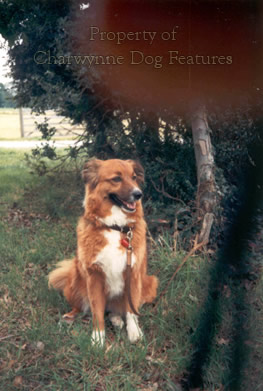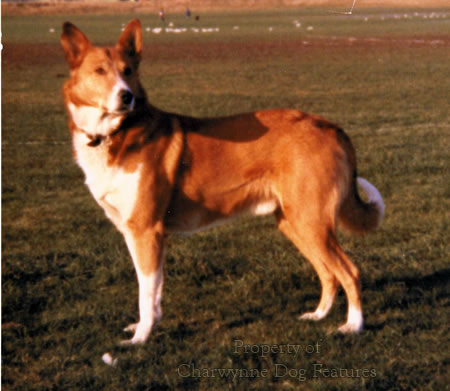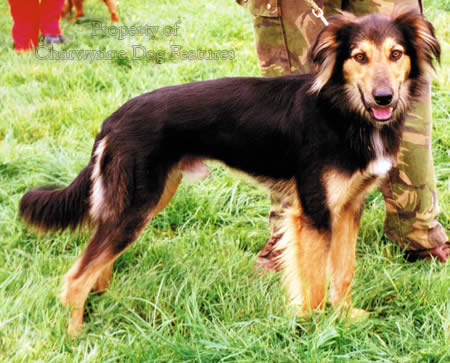864 RE-CREATING OUR LOST BREEDS
RE-CREATING OUR LOST BREEDS
by David Hancock
 Unlike some countries, Denmark, Portugal and Japan for example, we lack a society devoted to the conservation of our threatened native breeds of dog. In England we have already lost the English White Terrier, the Smithfield Sheepdog, the Norfolk Retriever and the Red Decoy Dog, our English Water Spaniel and Old English Black and Tan Terrier. Categorizing some low-in-number breeds merely as being 'vulnerable', as the Kennel Club has done, is purely a bureaucratic 'being seen to be doing something' ploy, rather than a genuine pro-active move to save breeds from slow, gradual extinction. When our Mastiff goes from 483 registrations in 2006 (and that is worrying enough) to just 139 in 2013 and our Bullmastiff numbers are reduced by two-thirds in a decade, whilst a comparable foreign breed, the Dogue de Bordeaux, goes from 1,500 a year to over 2,300 a year in the same time frame, there is justified concern about our own breeds. Canine diversity is all very well but not at the expense of our native breeds, past and present.
Unlike some countries, Denmark, Portugal and Japan for example, we lack a society devoted to the conservation of our threatened native breeds of dog. In England we have already lost the English White Terrier, the Smithfield Sheepdog, the Norfolk Retriever and the Red Decoy Dog, our English Water Spaniel and Old English Black and Tan Terrier. Categorizing some low-in-number breeds merely as being 'vulnerable', as the Kennel Club has done, is purely a bureaucratic 'being seen to be doing something' ploy, rather than a genuine pro-active move to save breeds from slow, gradual extinction. When our Mastiff goes from 483 registrations in 2006 (and that is worrying enough) to just 139 in 2013 and our Bullmastiff numbers are reduced by two-thirds in a decade, whilst a comparable foreign breed, the Dogue de Bordeaux, goes from 1,500 a year to over 2,300 a year in the same time frame, there is justified concern about our own breeds. Canine diversity is all very well but not at the expense of our native breeds, past and present.
In recent years, overseas nations, or their regions, have woken up to the loss of their ancient threatened breeds of dog. In Sicily, for example, they are conserving their cattle dog the Branchiero (resembling the Entlebucher of Switzerland), their flock guardian, the Mastino Siciliano (resembling a smaller black Maremma sheepdog), the Spino degli Iblei or Sicilian Beardie and the Vuccirisco (resembling a coarser Cane Corso, with a pug-like head). In Northern Italy too, they are looking for remaining examples of some of their lost rustic/pastoral breeds. I applaud such enlightened efforts. 
I believe that many of our breeds of English domestic dog are in unprecedented danger, not from one single distinct threat and not next year or the one after, but from a multiplicity of menaces over the next two decades. Some English breeds, like the Manchester Terrier, the Sussex and Field Spaniels, the Curly-coated Retriever, the Lancashire Heeler and the English Toy Terrier could simply fade away because of lack of numbers. Already there is concern over their immediate future. Their registrations in the early 21st century reveal the cause of this concern: fewer than 100 registrations annually for the Field and Sussex Spaniels, the Bloodhound, the Otterhound, and under 200 annually for the King Charles Spaniel, the Mastiff, the Norwich, Manchester and Smooth Fox Terriers, the Curly-coated Retriever and the English Toy Terrier; each is now an endangered species. For the nation that 'invented' terriers and retrievers this has to be shameful.
For the Scots, the Welsh and the Irish, as well as Australians, Germans, Czechs, Russians and now the Japanese and the Brazilians to have a national terrier and not the English is quite absurd! Even the Tibetans have one - at least by name! As did the Maltese, for a while, admittedly a Toy breed. Yet we did once have an English terrier, not a Toy, by name: the English White Terrier, once so well known and bred so true to type that a restoration would be justified and a regrettable gap in the list of terrier breeds filled. Writing in his "Terriers" of 1922, Darley Matheson recorded: "The writer would like to see really serious attempts made to revive the English white terrier, because it is a type, or rather variety, of dog which makes an excellent companion..." I support that and was interested to read of his recommended blend to resurrect the breed: a white Bull Terrier bitch to a white Whippet dog, with a further outcross to the Manchester Terrier. He envisaged a 15 to 18lb dog and outlined a likely Breed Standard. I suspect that the English White Terrier was, until the late 19th century, a distinct breed-type favoured by the working classes, especially by sweeps, pugilists and rat-catchers. The advent of dog shows brought about the pursuit of a more refined dog and this desire, closely followed by the ban on ear-cropping, led to the loss of a breed that should have become a national canine treasure.
Like the extinct English White Terrier, the English Water Spaniel was allowed by the KC to vanish from their lists. The majority of breeds now recognised by that body originated overseas. Whatever the merits of foreign dogs, and the patronage of exceptional dogs will always transcend national boundaries, the KC's new interest in preserving vulnerable native breeds such as the Skye, Dandie Dinmont and Sealyham terriers, is novel. In Belgium, their Mastiff has been saved but only through the lifelong devotion of one fancier, Alfons Bertels. One of Poland's oldest hound breeds, the Gonczy Polsky, has now been rescued from obscurity by a bunch of enthusiasts from the South Eastern part of Poland. If such breeds are only conserved by individuals acting unilaterally, what really is the point of national kennel clubs taking it upon themselves to oversee breed status? In the hound world it would be It would be good to see the Harrier being recognised, away from the packs, as it once was - by the KC. In the gundog world, and also once KC-registered, it would be great to have the English Water Spaniel featuring once again. Establishing its identity with so much variation in the working English Springer might however be difficult. I see the latter ranging from curly-coated to flat-coated specimens, standing 16" at the shoulder or almost two feet, featuring small smooth ears or judges' wigs for ears. Perhaps a re-created Water Spaniel should be solid-black, to preserve its individuality.
Never listed by the KC were the Smithfield Sheepdog (a leggy, shaggy-coated drover’s dog), the Blue Shag of Dorset (a mainly blue-grey bob-tailed sheepdog), the Cotswold Beardie (often black and white and possibly a variant of the Bobtail), the rough-haired Lakeland Sheepdog, the Welsh Hillman (the longer-legged uplands sheepdog of Wales), the Old Welsh Grey (the bearded sheepdog of Wales), the Welsh Black and Tan Sheepdog (the shorter-coated ‘valleys’ sheepdog of South Wales), the Galway Sheepdog of Southern Ireland (a big tricolour dog – resembling the Bernese Mountain Dog) and the Glenwherry Collie of Antrim (a mainly merle or marbled type, often wall-eyed), each one a distinct type, however little known outside their favoured areas. Every year, the use of pastoral dogs declines a little further, as modern pressures alter our agricultural methods and the urban sprawl continues. Just as valuable and equally clever were the decoy dogs used in duck-catching.
At the end of the last century "ginger 'coy dogs" were frequently to be seen alongside the gypsy dogs of the East Anglian travellers - silent clever and gifted poachers' dogs. The dog used as a decoy in duck hunting often worked in partnership with tame ducks to entice their wild relatives along ever-narrowing netted or caged channels until they were made captive. Jesse in his exhaustive "Researches into the History of the British Dog" of 1866 described how in the fens of Essex dogs resembling the "colly" were used with tame ducks to entice wildfowl into tunnel-nets. The skill of the decoy dog lies in giving the inquisitive ducks only fleeting and seemingly tantalising glimpses of its progress through the reeds and undergrowth, taking great care never to frighten them or even give them cause for suspicion. Before the use of firearms and indeed in the days when their range was very limited, these dogs must have been enormously valuable to duck-hunters.
The distinctive feature of dogs used in this way was the well-flagged tail. Their colour was usually fox-red, leading to some being referred to as fox-dogs, partly also because foxes will entice game by playful antics in a very similar vein. Clever little fox-like dogs have been used in many different countries in any number of ways in the pursuit of game: in Finland, their red-coated bark-pointer spitz transfixes feathered game by its mesmeric barking whilst awaiting the arrival of the hunters; in Japan, the russet-coated Shiba Inu was once used to flush birds for the falcon and the Tahl-tan Indians in British Columbia hunted bear, lynx and porcupine with their little black bear-dogs, which were often mistaken for foxes. The Nova Scotia Duck Tolling Retriever, now recognised by our KC, is, I believe, our red decoy dog taken to Canada by settlers at least two centuries ago. Our ancient breed has been revived but taken from us!
From time to time you can come across a throwback to our lost breeds; some enthusiasts too have attempted re-creation but received no support from the KC, which claims to represent dogs generally but actually only gives time to registered pedigree breeds. I see working spaniels looking just like depictions of our English Water Spaniel in the 19th century. I have come across dogs looking exactly like illustrations of the English White Terrier, the Welsh Hillman, the Red Decoy Dog, the Norfolk Retriever and the Old Black and Tan Sheepdog; the type is still in working genes and provides the material for a planned re-birth, if only some national interest could be aroused. We are often accused of neglecting our national treasures and disregarding our heritage - across a wide field. To neglect our canine heritage, in times when flawed genes are endangering so many pure-bred perhaps over-bred dogs, is most unwise. A breeding plan to revive and restore some of our lost breeds of dog could do a great deal towards the production of genetically-healthy, physically-sound and historically-important companion dogs. Step forward a wealthy far-seeing benefactor - there's work to be done!